|
| |
Back to Fighters
|
Argentina |
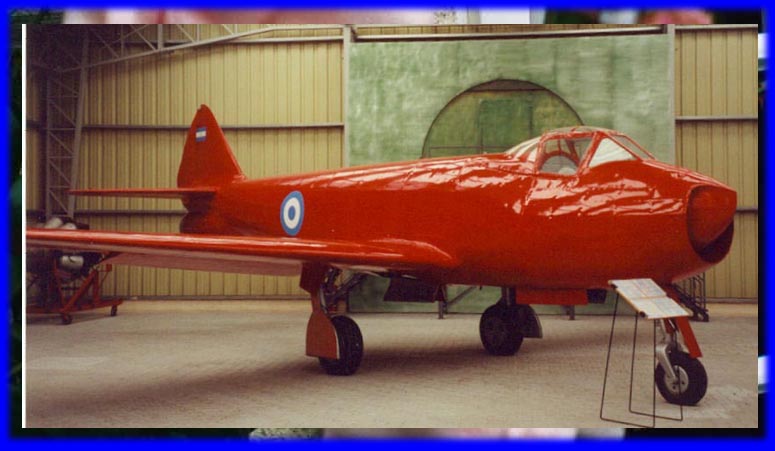 |
|
The FMA IA27 Pulqui was Argentina's first
(and I think only) jet fighter. It was built by the state aircraft
factory, Fabrica Militar de Aviones, and though it made Argentina
the sixth country in the world to fly a jet (after Germany, Britain,
America, Japan and Russia), it was not a success. It was designed by
French designer Emile Dewoitine, who had fled France thanks to the
second world war, and first flew in August 1947.
This one is preserved in the Argentine air force
museum at Buenos Aires, and was pictured in 1999. |
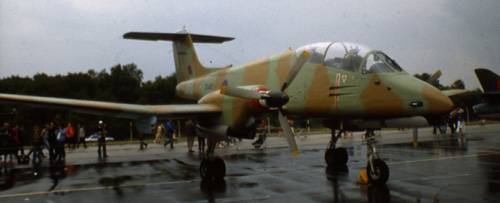 |
The FMA IA63 Pucara is unusual for a serious
attack aircraft in being turboprop powered. Its primary role is
counter insurgency. It is highly manoeuvrable, and capable of
operating from rough airstrips. It can carry a range of rockets,
missiles and bombs, and is also fitted with two cannon and four
machine guns.
This one was at Greenham Common in July 1983. |
|
Germany |
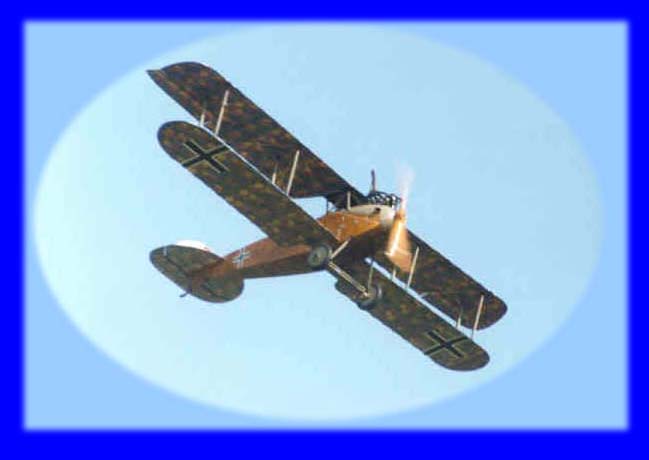 |
|
The LVG CVI is one of a tiny number of German
aircraft from the First World War still to be airworthy. It first
flew in 1918, and was just in time to serve in the war. It was quite
a bulky and heavy aircraft, unlike the agile Fokker Triplane. High
drag meant that it could only manage 105mph despite its huge 200hp
Daimler-Benz engine. Note the tall exhaust stack, taking the exhaust
over the top of the wing and well out of the pilot's way.
This one was flying at the Shuttleworth
Collection, Old Warden, in 1996, but has since retired from flying
and is displayed at the RAF Museum in Hendon. |
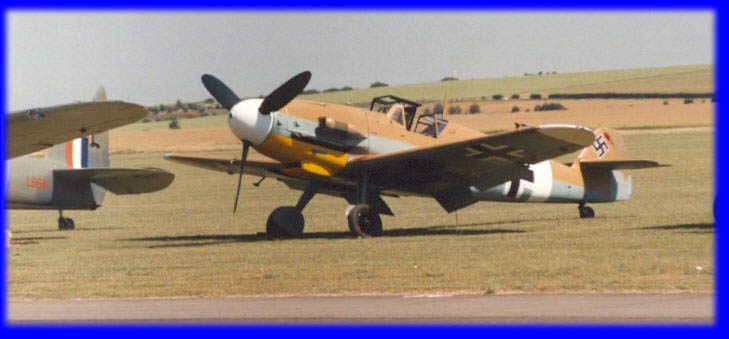 |
The Messerschmitt Bf109 is one of the most
famous German aircraft of all time. Broadly the German equivalent of
the Spitfire, it was exceptionally agile and performed very well
against all contemporary aircraft. It first flew in September 1935,
amazingly powered by a Rolls-Royce Kestrel engine! Subsequent
versions had Daimler-Benz DB605s. Several thousand were built;
they were still in production at the end of the war. SPanish air
force aircraft, powered even more ironically by Rolls-Royce Merlin
engines, continued in service well into the 1960s.
This Me109 was at Duxford in 1996. |
|
European
consortia |
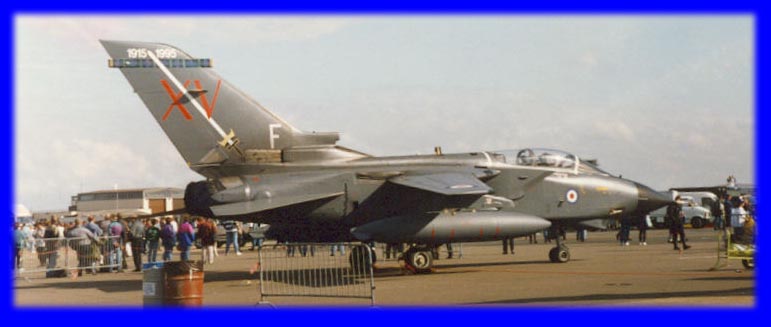 |
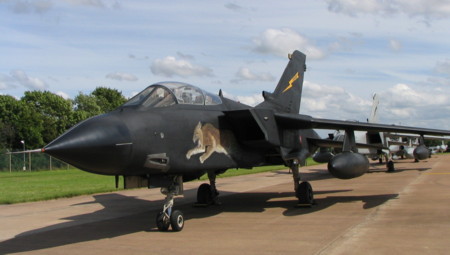 |
|
Panavia was a consortium comprising British
Aerospace, Deutsche Aerospace, and Italy's Alenia. It was formed
solely to design and produce the Tornado multi-role combat aircraft.
Designed to a specification not too different from the TSR2, it
first flew in August 1974. It has variable geometry (swing) wings.
Despite being criticised for being `jack of all trades, master of
none', it has become a very versatile and valuable combat aircraft
with about 1,000 produced for several air forces.
Top: Mildenhall in 1986.
Bottom: Special colour scheme, Fairford, July
2007. |
|
|
The SEPECAT (Societe Europeene pour le
Production de l'avion Ecole de Combat et Appui Tactique) Jaguar was
designed by a consortium of BAC (England) and Breguet (later
Dassault-Breguet) (France) to produce a tactical strike fighter. The
theory was to replace the Hunter; but, though very capable, the
Jaguar did not command the wide appeal of the earlier type. The RAF
bough t200 and the French 160. It first flew in September 1968, and
is still in service. The top picture is of
a Jaguar with considerable modification to the leading edge wing
roots for fly-by-wire advanced manouevrability trials, seen at
Farnborough in 1984. The lower picture is a Jaguar GR3A of 41
Squadron, seen at Fairford in July 2005. |
|
|
The Eurofighter Typhoon first flew in March
1994. 638 are in the process of being produced for Britain, Germany,
Italy and Spain. Most are single-seat fighters, but a few (including
the one pictured) are two seat conversion trainers. It is 52 feet 4
inches long with a wing span of 35 feet 11 inches. Its two Eurojet
EJ200 engines develop 20,000lb thrust, giving it a top speed of Mach
2 and, with gross weight of 51,800lb, a decent power to weight
ratio. It used a lot of the technology developed for the EAP, but
had a very long gestation period. This means that, although much
more advanced than the aircraft it will replace, it is already
behind the latest American equivalent, the F-22.
Top: a Typhoon T1, 29 OCU, Fairford, July 2005.
Lower: A Spanish Air Force Tifon, Fairford, July 2007. |
|
Netherlands |
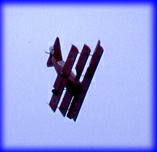 |
|
The Fokker DR1 Triplane was designed by
Reinhold Platz and built by Anthony Fokker for the German air force
in the First World War. It is probably best known as the type flown
by Manfred von Richthoven, the Red Baron. It entered service in
September 1917. Its agile performance outdid most of the Allied
fighters of the time. This is a replica,
pictured performing aerobatics at Rochester in August 1985. |
| Russia |
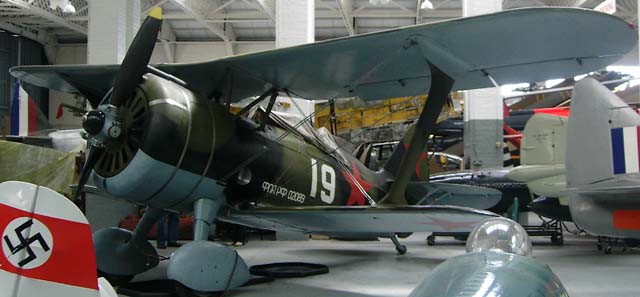 |
|
The Polikarpov i-15 is one of the few biplane
fighters to have served with distinction in the second world war
(another being the Gloster Gladiator). It first flew in October
1933. Power was a chunky 1,000lb M-62 radial. It managed 265mph and
carried a variety of armament - cannons and bombs.
This one is preserved at Duxford, and was seen
here in Summer 2005. |
|
|
The Mikoyan MiG21 (`Fishbed') is broadly the
Russian equivalent of the American F-4 Phantom, and was similarly
successful. The first MiG 21s entered service with the then Soviet
air force in the late 1950s. They were exported worldwide, mainly to
Soviet satellite countries. Its powerful Tumansky turbojet gave it a
top speed of Mach 2.1 at altitude. It is a relatively light aircraft
(9.5 tonnes maximum take-off), but agile.
The top one was at Farnborough in 1998. The lower
one, operated by the Romanian Air Force, was at Fairford in July
2005. |
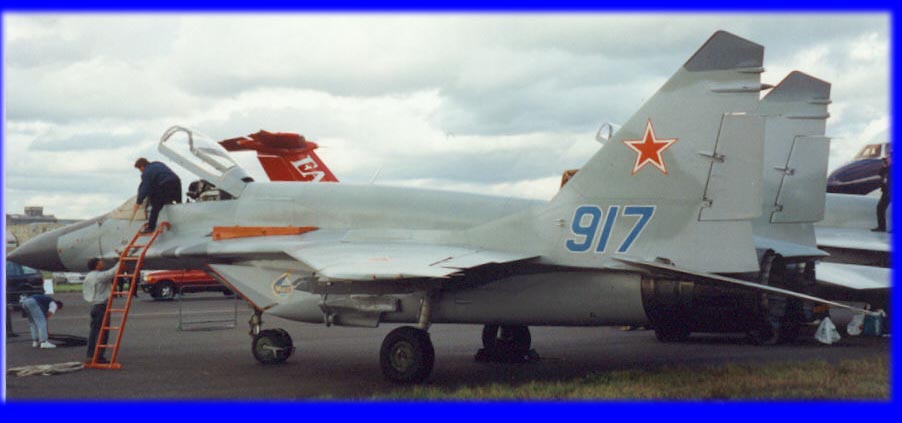
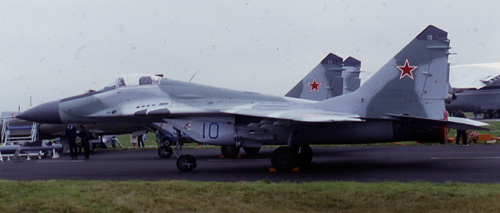 |
The Mikoyan MiG29 (`Fulcrum') is a small,
agile fighter, broadly comparable to the American F-16. Like the
F-16, it grew into a very capable multi-role aircraft, being agile
as well as having serious weapon load. As with many Soviet aircraft
of the era, its only real problem is the high fuel consumption.
These MiG29s were also at Farnborough in 1998. |
|
|
The Sukhoi Su22 ('Fitter') is an advanced
fighter with variable geometry wings. It is the export version of
the Su17, which first flew in August 1966. The Su17 was itself
derived from the earlier, fixed wing Su7 - one of the most famous
designs of the respected Russian engineer, Pavel Osipovich Sukhoi.
The wings swing between about 30 and 60 degrees. It is powered by a
17,200lb afterburning Lyulka AL-21 turbojet. Most are single seaters,
save for some built as two seaters for conversion training. It can
carry a variety of stores (bombs, rockets, missiles, fuel tanks and
the like) on eight external hardpoints. It is capable of over Mach
2, and has a combat radius of about 425 miles (mission dependent).
This Polish Air Force two seater was at Fairford, July 2005 |
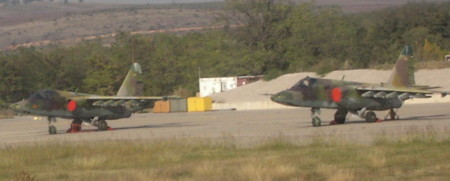 |
Sukhoi Su25 (`Frogfoot')
Skopje, October 2007 |
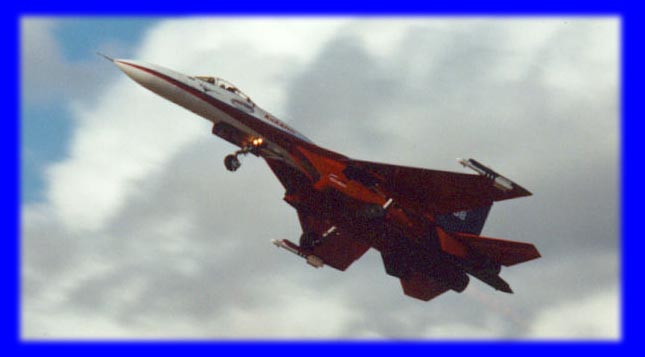 |
The Sukhoi Su27 (`Flanker') was broadly the
Soviet answer to the F-15E Strike Eagle. It is a very big, heavy
aircraft but its advanced control system makes it highly
manoeuvrable. Its party piece is called the `snakebite', when it
rears up beyond the vertical to get a shot at an opponent passing
overhead, then resumes its former course - a manoeuvre deemed
impossible by many Western aeronautical engineers, until they
actually saw it. This Su27 was also at
Farnborough in 1998. |
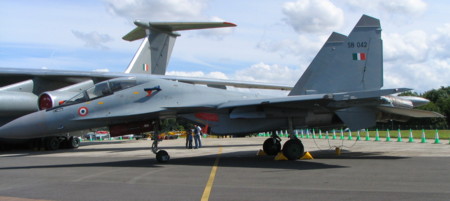 |
The Su30 is an improved version of the
Flanker with several advanced features such as the thrust-vectoring
thrust nozzles at the rear. Manoeuvrability is outstanding but the
market is limited; |
|
Sweden |
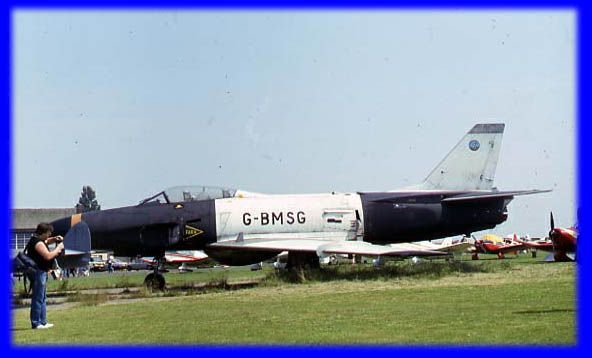 |
|
SAAB (Svenska Aeroplan AB) Lansen was
designed shortly after the war for the Swedish air force, as part of
Sweden's active policy of policing its neutrality by means of an
indigenous aircraft industry. It first flew in 1952. About 280 were
built and operated by the Swedish air force until 1978. Like the
contemporaneous Hunter, it was just supersonic.
After retirement, a few found their way to
private owners, including this one seen at Cranfield in July 1987.
|
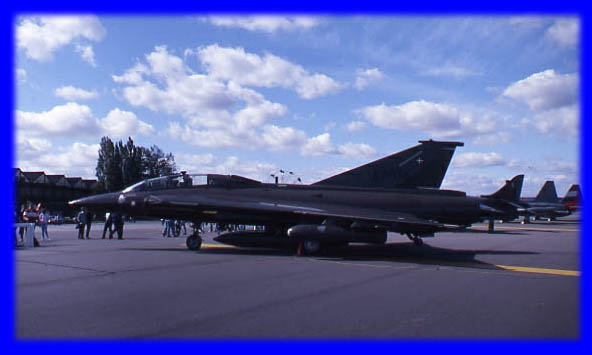 |
The SAAB Draken was a multi-purpose fighter
which first flew in Summer 1967. It is unusual in having a
double-delta wing. It is fully supersonic, with top speed of Mach
2.0 at altitude. It was operated by Denmark and Finland apart from
Sweden. An attempt to procure Drakens for Austria aroused huge
opposition because of the noise! This
two seat Sk35b was at Upper Heyford in August 1986. |
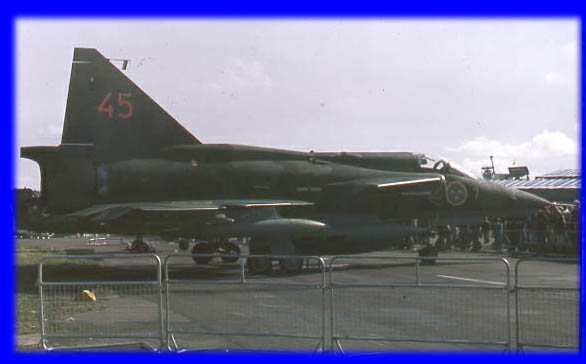 |
SAAB produced the Viggen as a multi-role
complement for the Draken. It first flew the same year, 1967. Its
layout is even more unusual, having two delta wings (the main one
and a much smaller canard delta mounted on the air intake. But it
would be unkind to describe it as a jet biplane, because it is very
capable and agile as well as having a high load capacity. Among
other odd features, it is specifically designed to be operated from
motorways in case its base airfield is damaged.
This one was at Farnborough in September 1976. |
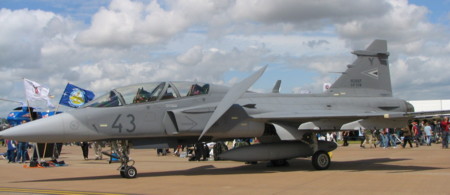 |
The SAAB Gripen is the latest in the line of
independent lightweight fighters from the Swedish company. It first
flew in December 1988. Development was somewhat extended due to
issues with the highly advanced computer-controlled flight
management system (a software bug caused the tragic loss of an early
prototype). It is now successfully in service with the Swedish,
Czech and Hungarian air forces, with over 180 delivered at the time
of writing (July 2007). It is 46'3" long, with a wing span of 27'7".
Its 80kN Volvo RM12 engine gives it a top speed of Mach 2, combat
range of 430 miles and gross weight of 31,000lb.
This is a two seat JAS39B of the
Hungarian Air Force, Fairford, July 2007 |
|
Yugoslavia |
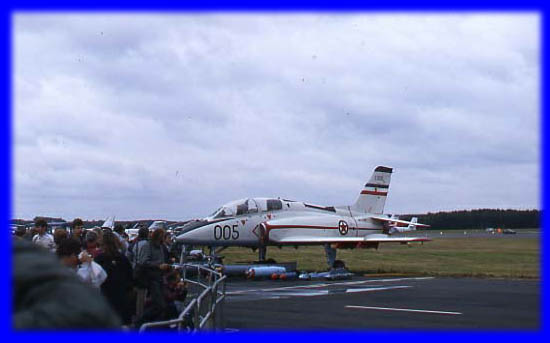 |
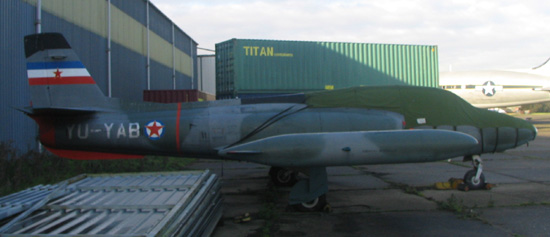 |
|
The Soko Galeb, and its single seat
counterpart the Jastreb, was the first jet to be made by Yugoslavia.
It first flew in 1961, but was subsequently updated many times to
take advantage of new technology. It is really a trainer, but with
good ground attack capability. It could be regarded as being in a
similar category to the British Hawk (listed under Trainers). It is
powered by a Rolls-Royce Viper turbojet.
Top: Super Galeb, demonstrated at Farnborough in
September 1984. Lower picture: An original Galeb (note the wingtip
fuel tanks) at North Weald, December 2005. |





|